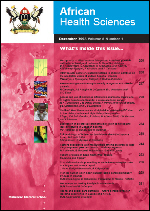
|
African Health Sciences
Makerere University Medical School
ISSN: 1680-6905
EISSN: 1680-6905
Vol. 16, No. 3, 2016, pp. 831-837
|
 Bioline Code: hs16105
Bioline Code: hs16105
Full paper language: English
Document type: Study
Document available free of charge
|
|
|
African Health Sciences, Vol. 16, No. 3, 2016, pp. 831-837
| en |
Can we predict agitation in patients with suicide attempts in the emergency department?
Ayhan, Akoz; Sultan Tuna Akgol, Gur; Elif, Oral; Ummu Zeynep, Avsar & Mucahit, Emet
Abstract
Background: The agitation in patients presenting to the emergency department (ED) after suicide attempts is common and an
important problem.
Objective: To establish whether we can predict agitated patients among suicide attempt patients in ED.
Methods: This is a cross-sectional observational study of adult suicide attempt events in ED. Information was collected prospectively
on a specially designed data-collection form. Patients aged 16 years old and above who presented to the ED for care
due to suicide attempts were included in the study. Suicide attempts were grouped as aggressive and non-aggressive attempts.
Results: A total of 533 patients were included. Forty-three of these patients had agitation in ED (8%). Non-aggressive suicide
attempts were referred to psychiatry services more than aggressive ones (73.6%, n=345 vs 32.8%, n=21, P<0.0001). Agitation
in ED and being male increased aggressive suicide attempt risk 3.5 (95% CI:1.6-7.6) and 3.2 times (95% CI:1.8-5.5), respectively.
Agitation was statistically more frequent among these patients: those on antidepressant overdose, with previous suicide attempt;
with aggressive suicide attempt; and those with confusion; and unconsciousness (P<0.05).
Conclusion: Patients who attempted suicide and whose risk of harm to others included those with: antidepressant overdose,
aggressive suicide attempt and the unconscious. Response teams should be prepared for these subgroups.
Keywords
Agitation; suicide attempt; deliberate self-harm
|
| |
© Copyright 2016 - African Health Sciences
|
|
